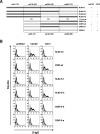Highly conserved regions within the spike proteins of human coronaviruses 229E and NL63 determine recognition of their respective cellular receptors
- PMID: 16912312
- PMCID: PMC1563880
- DOI: 10.1128/JVI.00560-06
Highly conserved regions within the spike proteins of human coronaviruses 229E and NL63 determine recognition of their respective cellular receptors
Abstract
We have recently demonstrated that the severe acute respiratory syndrome coronavirus (SARS-CoV) receptor angiotensin converting enzyme 2 (ACE2) also mediates cellular entry of the newly discovered human coronavirus (hCoV) NL63. Here, we show that expression of DC-SIGN augments NL63 spike (S)-protein-driven infection of susceptible cells, while only expression of ACE2 but not DC-SIGN is sufficient for entry into nonpermissive cells, indicating that ACE2 fulfills the criteria of a bona fide hCoV-NL63 receptor. As for SARS-CoV, murine ACE2 is used less efficiently by NL63-S for entry than human ACE2. In contrast, several amino acid exchanges in human ACE2 which diminish SARS-S-driven entry do not interfere with NL63-S-mediated infection, suggesting that SARS-S and NL63-S might engage human ACE2 differentially. Moreover, we observed that NL63-S-driven entry was less dependent on a low-pH environment and activity of endosomal proteases compared to infection mediated by SARS-S, further suggesting differences in hCoV-NL63 and SARS-CoV cellular entry. NL63-S does not exhibit significant homology to SARS-S but is highly related to the S-protein of hCoV-229E, which enters target cells by engaging CD13. Employing mutagenic analyses, we found that the N-terminal unique domain in NL63-S, which is absent in 229E-S, does not confer binding to ACE2. In contrast, the highly homologous C-terminal parts of the NL63-S1 and 229E-S1 subunits in conjunction with distinct amino acids in the central regions of these proteins confer recognition of ACE2 and CD13, respectively. Therefore, despite the high homology of these sequences, they likely form sufficiently distinct surfaces, thus determining receptor specificity.
Figures







Similar articles
-
The S proteins of human coronavirus NL63 and severe acute respiratory syndrome coronavirus bind overlapping regions of ACE2.Virology. 2007 Oct 25;367(2):367-74. doi: 10.1016/j.virol.2007.04.035. Epub 2007 Jul 12. Virology. 2007. PMID: 17631932 Free PMC article.
-
Human coronavirus NL63 employs the severe acute respiratory syndrome coronavirus receptor for cellular entry.Proc Natl Acad Sci U S A. 2005 May 31;102(22):7988-93. doi: 10.1073/pnas.0409465102. Epub 2005 May 16. Proc Natl Acad Sci U S A. 2005. PMID: 15897467 Free PMC article.
-
Characterization of spike S1/S2 processing and entry pathways of lentiviral pseudoviruses bearing seasonal human coronaviruses NL63, 229E, and HKU1 spikes.Microbiol Spectr. 2025 Mar 4;13(3):e0280824. doi: 10.1128/spectrum.02808-24. Epub 2025 Jan 28. Microbiol Spectr. 2025. PMID: 39873512 Free PMC article.
-
Properties of Coronavirus and SARS-CoV-2.Malays J Pathol. 2020 Apr;42(1):3-11. Malays J Pathol. 2020. PMID: 32342926 Review.
-
Severe acute respiratory syndrome coronavirus entry as a target of antiviral therapies.Antivir Ther. 2007;12(4 Pt B):639-50. Antivir Ther. 2007. PMID: 17944271 Review.
Cited by
-
Link of a ubiquitous human coronavirus to dromedary camels.Proc Natl Acad Sci U S A. 2016 Aug 30;113(35):9864-9. doi: 10.1073/pnas.1604472113. Epub 2016 Aug 15. Proc Natl Acad Sci U S A. 2016. PMID: 27528677 Free PMC article.
-
Sequence and phylogentic analysis of MERS-CoV in Saudi Arabia, 2012-2019.Virol J. 2021 Apr 30;18(1):90. doi: 10.1186/s12985-021-01563-7. Virol J. 2021. PMID: 33931099 Free PMC article.
-
The receptor binding domain of the new Middle East respiratory syndrome coronavirus maps to a 231-residue region in the spike protein that efficiently elicits neutralizing antibodies.J Virol. 2013 Aug;87(16):9379-83. doi: 10.1128/JVI.01277-13. Epub 2013 Jun 19. J Virol. 2013. PMID: 23785207 Free PMC article.
-
Identification of the Receptor-Binding Domain of the Spike Glycoprotein of Human Betacoronavirus HKU1.J Virol. 2015 Sep;89(17):8816-27. doi: 10.1128/JVI.03737-14. Epub 2015 Jun 17. J Virol. 2015. PMID: 26085157 Free PMC article.
-
Proteolytic processing and deubiquitinating activity of papain-like proteases of human coronavirus NL63.J Virol. 2007 Jun;81(11):6007-18. doi: 10.1128/JVI.02747-06. Epub 2007 Mar 28. J Virol. 2007. PMID: 17392370 Free PMC article.
References
Publication types
MeSH terms
Substances
Grants and funding
LinkOut - more resources
Full Text Sources
Other Literature Sources
Research Materials
Miscellaneous

